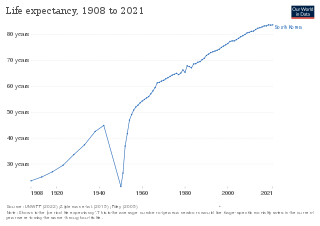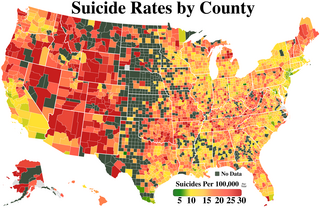Related Research Articles
Suicide is the second leading cause of death for people in the United States from the ages of 9 to 56.

Jumping from a dangerous location, such as from a high window, balcony, or roof, or from a cliff, dam, or bridge, is an often used suicide method. The 2023 ICD-10-CM diagnosis code for jumping from a high place is X80*, and this method of suicide is also known clinically as autokabalesis. Many countries have noted suicide bridges such as the Nanjing Yangtze River Bridge and the Golden Gate Bridge. Other well known suicide sites for jumping include the Eiffel Tower and Niagara Falls.
There are more than 700,000 estimated suicide deaths every year. Suicide affects every demographic, yet there are some populations that are more impacted than others. For example, among 15–29 year olds, suicide is much more prominent; this being the fourth leading cause of death within this age group.

Suicidal ideation, or suicidal thoughts, is the thought process of having ideas, or ruminations about the possibility of completing suicide. It is not a diagnosis but is a symptom of some mental disorders, use of certain psychoactive drugs, and can also occur in response to adverse life events without the presence of a mental disorder.

Life expectancy has been rising rapidly and South Korea ranked 3rd in the world for life expectancy. South Korea has among the lowest HIV/AIDS adult prevalence rate in the world, with just 0.1% of the population being infected, significantly lower than the U.S. at 0.6%, France's 0.4%, and the UK's 0.3% prevalence rate. South Korea has a good influenza vaccination rate, with a total of 43.5% of the population being vaccinated in 2019. A new measure of expected human capital calculated for 195 countries from 1920 to 2016 and defined for each birth cohort as the expected years lived from age 20 to 64 years and adjusted for educational attainment, learning or education quality, and functional health status was published by the Lancet in September 2018. South Korea had the sixth highest level of expected human capital with 26 health, education, and learning-adjusted expected years lived between age 20 and 64 years.

Suicide is the act of intentionally causing one's own death. Mental disorders, physical disorders, and substance abuse are risk factors. Some suicides are impulsive acts due to stress, relationship problems, or harassment and bullying. Those who have previously attempted suicide are at a higher risk for future attempts. Effective suicide prevention efforts include limiting access to methods of suicide such as firearms, drugs, and poisons; treating mental disorders and substance abuse; careful media reporting about suicide; improving economic conditions; and dialectical behaviour therapy (DBT). Although crisis hotlines are common resources, their effectiveness has not been well studied.

Gender differences in suicide rates have been shown to be significant. There are different rates of suicides and suicidal behavior between males and females. While females more often have suicidal thoughts, males die by suicide more frequently. This discrepancy is also known as the gender paradox in suicide.

Suicide is a major national public health issue in the United States. The country has one of the highest suicide rates among wealthy nations. In 2020, there were 45,799 recorded suicides, up from 42,773 in 2014, according to the CDC's National Center for Health Statistics (NCHS). On average, adjusted for age, the annual U.S. suicide rate increased 30% between 2000 and 2020, from 10.4 to 13.5 suicides per 100,000 people. In 2018, 14.2 people per 100,000 died by suicide, the highest rate recorded in more than 30 years. Due to the stigma surrounding suicide, it is suspected that suicide is generally underreported. In April 2016, the CDC released data showing that the suicide rate in the United States had hit a 30-year high, and later in June 2018, released further data showing that the rate has continued to increase and has increased in every U.S. state except Nevada since 1999. From 2000 to 2020, more than 800,000 people died by suicide in the United States, with males representing 78.7% of all suicides that happened between 2000 and 2020. In 2022, a record high 49,500 people died by suicide, while the suicide rate in 2022 reached its highest level since 1941 at 14.3 per 100,000 persons. Surging death rates from suicide, drug overdoses and alcoholism, what researchers refer to as "deaths of despair", are largely responsible for a consecutive three year decline of life expectancy in the U.S. This constitutes the first three-year drop in life expectancy in the U.S. since the years 1915–1918.
China's suicide rates were one of the highest in the world in the 1990s. However, by 2011, China had one of the lowest suicide rates in the world. According to the World Health Organization, the suicide rate in China was 9.7 per 100,000 as of 2016. As a comparison, the suicide rate in the U.S. in 2016 was 15.3. Generally speaking, China seems to have a lower suicide rate than neighboring Korea, Russia and Japan, and it is more common among women than men and more common in the Yangtze Basin than elsewhere.
Suicide is a major national public health issue in the India. 1.71 lakh suicides were recorded in 2022, registering a 4.2% increase over 2021 and a jump of 27% compared to 2018. The rate of suicide per one lakh population has increased to 12.4 in 2022 which is the highest rate of deaths from suicides since 1967, which is the earliest recorded year for this data. Suicides during 2022 increased by 27% in comparison to 2018 with India reporting highest number of suicides in the world. India's contribution to global suicide deaths increased from 25.3% in 1990 to 36.6% in 2016 among women, and from 18.7% to 24.3% among men. In 2016, suicide was the most common cause of death in both the age groups of 15–29 years and 15–39 years. Daily wage earners accounted for 26% of suicide victims, the largest group in the suicide data.
A suicide attempt is an act in which an individual tries to kill themselves but survives. Mental health professionals discourage describing suicide attempts as "failed" or "unsuccessful", as doing so may imply that a suicide resulting in death is a successful or desirable outcome.
Researchers study Social media and suicide to find if a correlation exists between the two. Some research has shown that there may be a correlation.
Suicide and the Internet have increasingly important relationships as Internet use becomes more ubiquitous.

Switzerland had a standardised suicide rate of 10.7 per 100,000 as of 2015. The actual (non-standardised) rate was 12.5 in 2014.

According to the latest available data, Statistics Canada estimates 4,157 suicides took place in Canada in 2017, making it the 9th leading cause of death, between Alzheimer's disease (8th) and cirrhosis and other liver diseases (10th). In 2009, there were an estimated 3,890 suicide deaths.

Suicide is a significant national social issue in the United Kingdom. In 2019 there were 5,691 registered deaths by suicide in England and Wales, equating to an average of 18 suicides per day. Suicide is the single biggest killer of men under the age of 45 in the country.
In colleges and universities in the United States, suicide is one of the most common causes of death among students. Each year, approximately 24,000 college students attempt suicide while 1,100 students succeed in their attempt, making suicide the second-leading cause of death among U.S. college students. Roughly 12% of college students report the occurrence of suicide ideation during their first four years in college, with 2.6% percent reporting persistent suicide ideation. 65% of college students reported that they knew someone who has either attempted or died by suicide, showing that the majority of students on college campuses are exposed to suicide or suicidal attempts.
Suicide is a significant social issue in Afghanistan.
Youth suicide in India is when young Indian people deliberately end their own life. People aged 15 to 24 years have the highest suicide rate in India, which is consistent with international trends in youth suicide. 35% of recorded suicides in India occur in this age group. Risk factors and methods of youth suicide differ from those in other age groups.
References
- ↑ "Suicide mortality rate (per 100,000 population)". The World Bank. Retrieved 2024-05-04.
- ↑ "Pakistan Death rate - data, chart". TheGlobalEconomy.com. Retrieved 2019-01-04.
- ↑ "Suicide Rate Increasing In Pakistan". The Friday Times. 2023-02-12. Retrieved 2023-09-17.
- 1 2 3 Khan, Murad Moosa; Reza, Hashim (2000). "The pattern of suicide in Pakistan". Crisis. 21 (1): 31–5. doi:10.1027/0227-5910.21.1.31. PMID 10793469.
- ↑ "Pakistan abolishes colonial-era law that punishes attempted suicide: Report". Hindustan Times. 2022-12-23. Retrieved 2023-08-28.
- ↑ Khan, Murad Moosa (1998). "Suicide and attempted suicide in Pakistan". Crisis. 19 (4): 172–6. doi:10.1027/0227-5910.19.4.172. PMID 10331315.
- ↑ Hassan, Sohaib (February 27, 2009). "Suicide Prevention in Pakistan". Chowk.com . Archived from the original on September 22, 2011. Retrieved July 2, 2011.